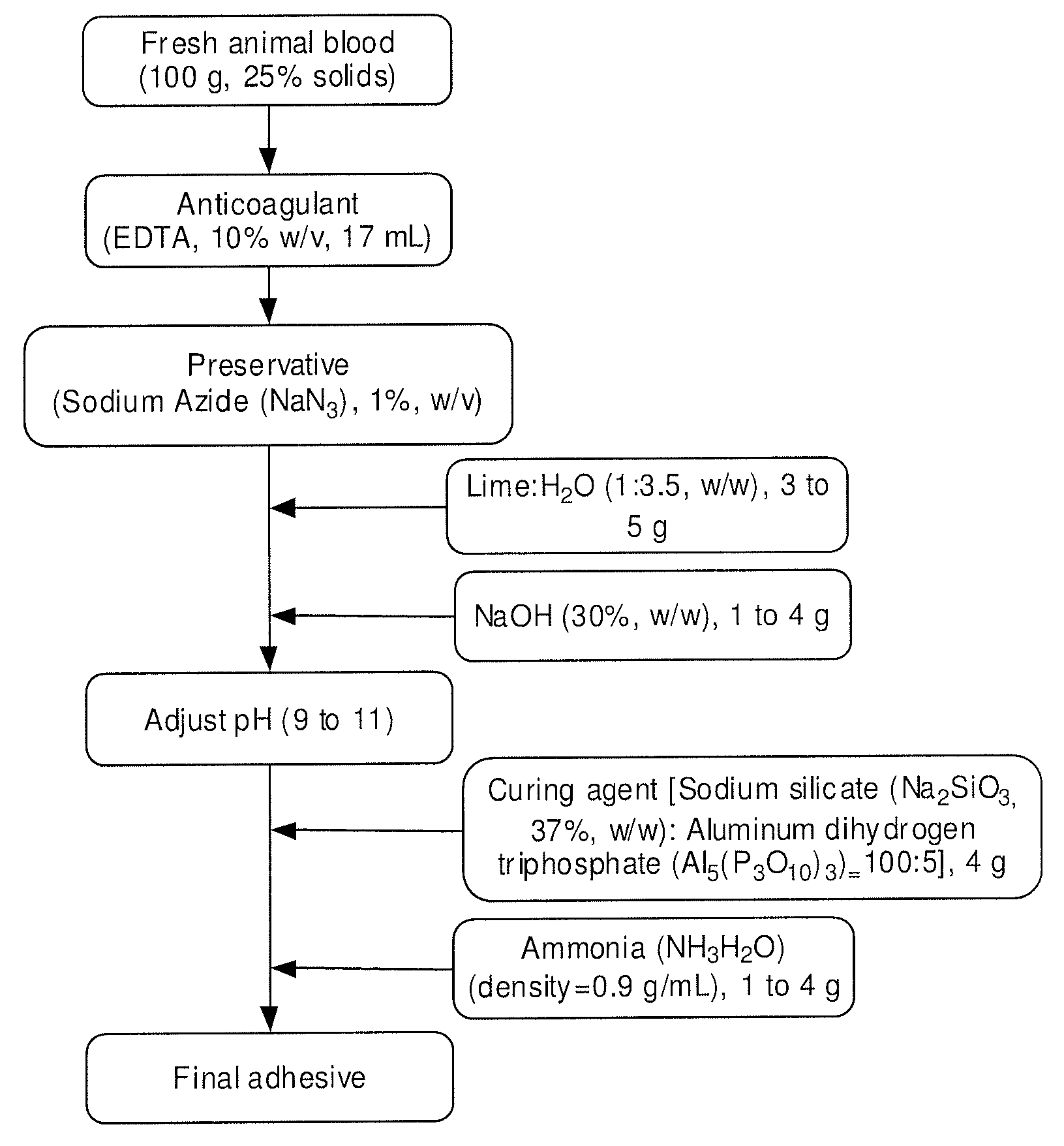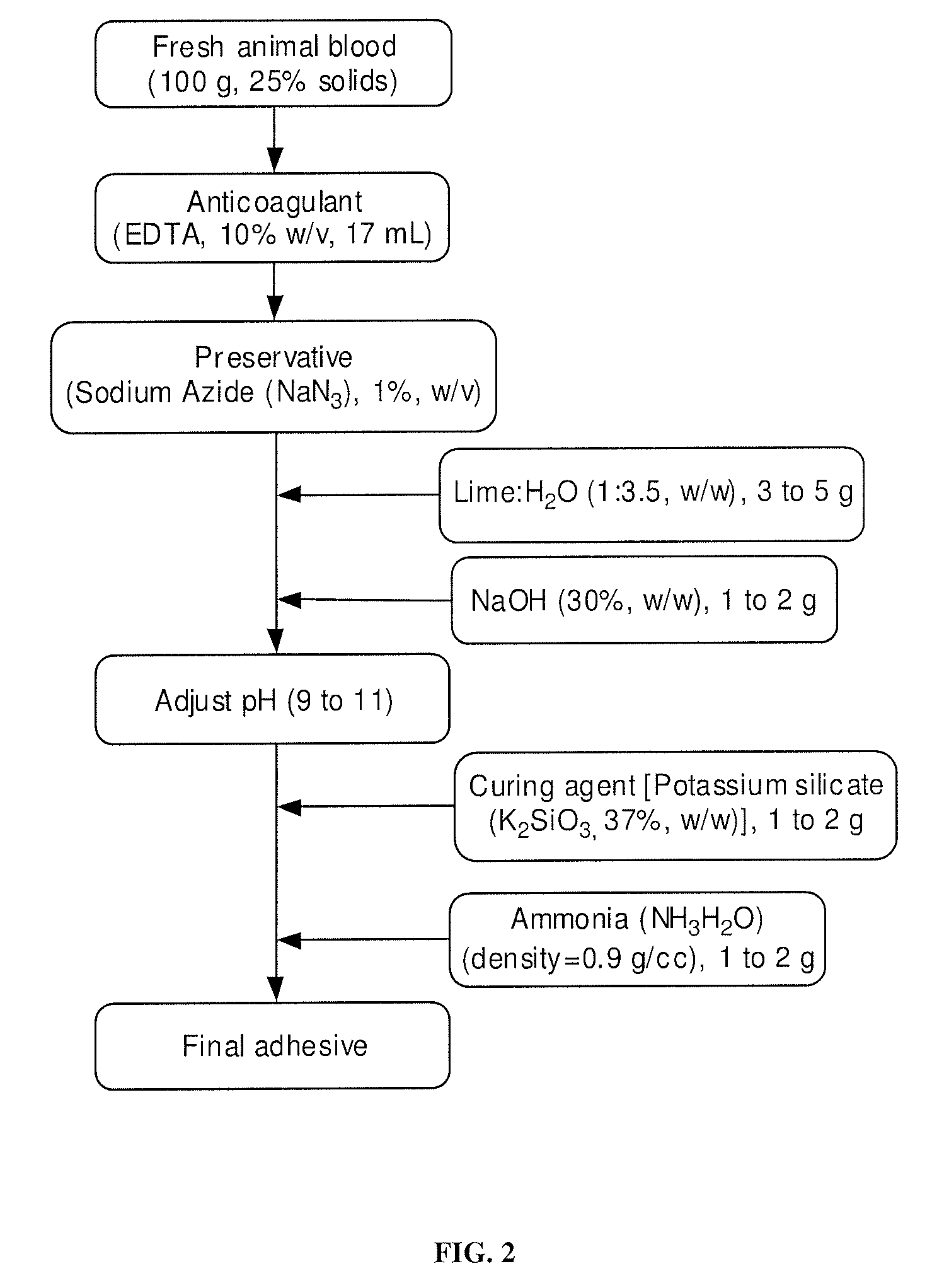Glue from slaughterhouse animal blood
a technology of slaughterhouse animals and glue, applied in the field of glue from slaughterhouse animal blood, can solve the problems of inability to scale up economically, the process was becoming increasingly rare, and the coniferous woods are not amenable to hot pressing with wet blood glue, etc., to inhibit the growth of bacteria in the blood and inhibit the coagulation of blood
- Summary
- Abstract
- Description
- Claims
- Application Information
AI Technical Summary
Benefits of technology
Problems solved by technology
Method used
Image
Examples
example 1
Materials and Methods
[0028]Adhesive A: Fresh cow or pig blood, with a solids content around 25% (w / w) and at a temperature of from about 25° C. to about 35° C. was used, without any dewatering of the blood.
[0029]To 100 g of the fresh blood the following reagents were added (with stirring) in sequence with about a 1 to 2 min interval after each step:[0030]1) 1.7 mL ethylenediamine tetraacetic acid (EDTA, 10%, w / w);[0031]2) sodium azide (0.5 mL);[0032]3) lime milk (1:3.5 w / w), 3 to 5 g;[0033]4) caustic soda (i.e., NaOH) (30% w / w), 1 to 4 g;[0034]5) mixture of sodium silicate (37%) and aluminum dihydrogen triphosphate (ADT) powder (100:5 w / w), 4 to 5 g; and[0035]6) ammonia (density 0.9 g / mL), 1 to 4 g.
[0036]The resulting mixture is the final adhesive. See FIG. 1.
[0037]Adhesive B: The same procedure as given above for Adhesive A was used, except that in step (5) potassium silicate 1 to 2 g (37%) was used in place of the sodium silicate-ADT mixture. See FIG. 2.
[0038]Adhesive C: The same ...
example 2
[0043]Improved adhesive strength and water resistance is observed for adhesives prepared from fresh cow blood. However, the viscosity of alkali-modified blood protein adhesives increases during storage, which makes it difficult to apply. The increase in viscosity is due to increased intermolecular interactions among unfolded protein molecules. Sodium metaphosphate (Na6P6O18, 0.02% of fresh blood, w / w) was selected as a reducing agent to weaken the electrostatic and covalent bonds, which minimized the intermolecular interactions and stabilized the viscosity during storage.
Materials and Methods
[0044]In 5 ml water, 0.06 g solid sodium metaphosphate were dissolved. The sodium metaphosphate solution was then added to prepared Adhesive B and stirred thoroughly. The prepared glue was then separated into three portions, the first of which was stored 5 days before being used, the second of which was stored 30 days before being used, and the third of which was stored 60 days before being used...
PUM
| Property | Measurement | Unit |
|---|---|---|
| wt % | aaaaa | aaaaa |
| density | aaaaa | aaaaa |
| temperature | aaaaa | aaaaa |
Abstract
Description
Claims
Application Information
 Login to View More
Login to View More - R&D
- Intellectual Property
- Life Sciences
- Materials
- Tech Scout
- Unparalleled Data Quality
- Higher Quality Content
- 60% Fewer Hallucinations
Browse by: Latest US Patents, China's latest patents, Technical Efficacy Thesaurus, Application Domain, Technology Topic, Popular Technical Reports.
© 2025 PatSnap. All rights reserved.Legal|Privacy policy|Modern Slavery Act Transparency Statement|Sitemap|About US| Contact US: help@patsnap.com



